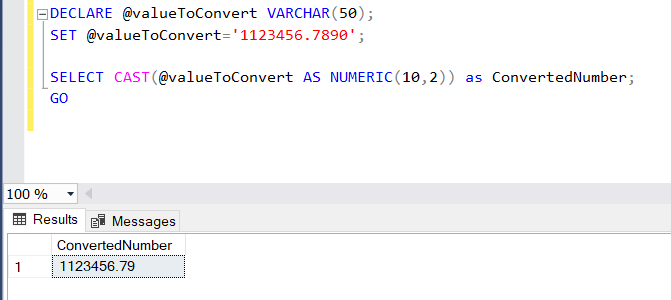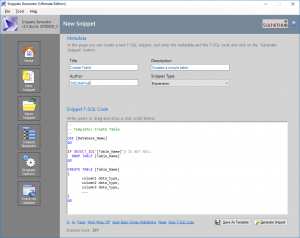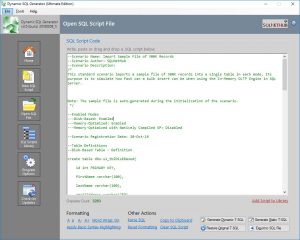While developing data processes in SQL Server, under certain circumstances, you might get the error message: error converting varchar to numeric. This error is similar with the conversion error you might get when you are trying to convert a varchar to float, etc.
Read on to find out the reason for getting this error message and how you can easily resolve it within just a minute.
The Numeric Data Type in SQL Server
Prior to discuss how you can reproduce and resolve the issue, it is important that you first understand the numeric data type in SQL Server. As described in the relevant MS Docs article, the numeric data type has fixed precision and scale, and it has equivalent functionality with the decimal data type.
Arguments
The numeric data type takes two arguments, that is precision and scale. The syntax is numeric(precision, scale).
Precision defines the maximum number of decimal digits (in both sides of the number) and its value range is between 1 and 38.
Scale, defines the number of decimal digit that will be stored to the right of the decimal point. Its value can range between 1 and the value specified for precision.
Here’s an example of a numeric data type value in SQL Server:
DECLARE @numValue NUMERIC(10,2); SET @numValue=123456.7890 SELECT @numValue as NumValue; GO
The number returned by the above T-SQL query is: 123456.7890
In the above example I specified as precision 10 and as scale 2.
So, even though I specified 123456.7890 as the numeric value, it was indirectly converted to a numeric(10,2) value and that’s why it returned the value 123456.79
Learn more tips like this! Enroll to our Online Course!
Check our online course titled “Essential SQL Server Development Tips for SQL Developers”
(special limited-time discount included in link).Sharpen your SQL Server database programming skills via a large set of tips on T-SQL and database development techniques. The course, among other, features over than 30 live demonstrations!
(Lifetime Access/ Live Demos / Downloadable Resources and more!) Enroll from $12.99
Reproducing the Conversion Error
Great. Now, let’s reproduce the conversion error by trying to convert a “problematic” varchar value to numeric.
You can find this example below:
DECLARE @valueToConvert VARCHAR(50); SET @valueToConvert='1123,456.7890'; SELECT CAST(@valueToConvert AS NUMERIC(10,2)) as ConvertedNumber; GO
When you execute the above T-SQL code, you will get the below exact error message:
Msg 8114, Level 16, State 5, Line 4
Error converting data type varchar to numeric.
How to Resolve the Conversion Error
As you might have observed in the above example, the @valueToConvert variable, besides the dot (.), it also contains a comma (,).
Therefore, at the time of its conversion to the numeric data type, the comma is considered an illegal character for the destination data type (numeric) and that’s why you get the error message.
In order to resolve the conversion error, you just need to remove the comma (,) from the varchar value that you want to convert to numeric.
Note: At this point, you also need to make sure that the varchar value to be converted, is the actual number you wish to convert to the numeric data type. Also, you need to make sure that you only use the decimal symbol, in this case the dot (.), and not any digit grouping symbols, etc.
So, if we remove the comma from the above example, we can see that the conversion is successful.
DECLARE @valueToConvert VARCHAR(50); SET @valueToConvert='1123456.7890'; SELECT CAST(@valueToConvert AS NUMERIC(10,2)) as ConvertedNumber; GO
Output:
In general, when converting varchar values to numbers (i.e. decimal, numeric, etc.), you need to be careful in order for your varchar value, not contain any digit grouping symbols (i.e. a comma) or any other characters that do not have a meaning as a number.
Check our Online Courses
- SQL Server 2022: What’s New – New and Enhanced Features
- Data Management for Beginners – Main Principles
- Introduction to Azure Database for MySQL
- Working with Python on Windows and SQL Server Databases
- Boost SQL Server Database Performance with In-Memory OLTP
- Introduction to Azure SQL Database for Beginners
- Essential SQL Server Administration Tips
- SQL Server Fundamentals – SQL Database for Beginners
- Essential SQL Server Development Tips for SQL Developers
- Introduction to Computer Programming for Beginners
- .NET Programming for Beginners – Windows Forms with C#
- SQL Server 2019: What’s New – New and Enhanced Features
- Entity Framework: Getting Started – Complete Beginners Guide
- A Guide on How to Start and Monetize a Successful Blog
- Data Management for Beginners – Main Principles
Read Also
Feel free to check our other relevant articles on SQL Server troubleshooting:
- Error converting data type varchar to float
- Rule “Setup account privileges” failed – How to Resolve
- SQL Server 2022: What’s New – New and Enhanced Features (Course Preview)
- SQLServerAgent could not be started (reason: Unable to connect to server ‘(local)’; SQLServerAgent cannot start)
- ORDER BY items must appear in the select list if SELECT DISTINCT is specified
- There is no SQL Server Failover Cluster Available to Join
- There is insufficient system memory in resource pool ‘internal’ to run this query.
- There is not enough space on the disk. (mscorlib)
- A network-related or instance-specific error occurred while establishing a connection to SQL Server
- Introduction to Azure Database for MySQL (Course Preview)
- [Resolved] Operand type clash: int is incompatible with uniqueidentifier
- The OLE DB provider “Microsoft.ACE.OLEDB.12.0” has not been registered – How to Resolve it
- SQL Server replication requires the actual server name to make a connection to the server – How to Resolve it
- Issue Adding Node to a SQL Server Failover Cluster – Greyed Out Service Account – How to Resolve
- Resolve SQL Server CTE Error – Incorrect syntax near ‘)’.
- SQL Server is Terminating Because of Fatal Exception 80000003 – How to Troubleshoot
- An existing History Table cannot be specified with LEDGER=ON – How to Resolve
- Advanced SQL Server Features and Techniques for Experienced DBAs
- SQL Server Database Backup and Recovery Guide
- … all SQL Server troubleshooting articles
Featured Database Productivity Tools
Snippets Generator: Create and modify T-SQL snippets for use in SQL Management Studio, fast, easy and efficiently.
Learn more
Dynamic SQL Generator: Convert static T-SQL code to dynamic and vice versa, easily and fast.
Learn more
Subscribe to our newsletter and stay up to date!
Check out our latest software releases!
Check our eBooks!
Rate this article: 
Loading…
Reference: SQLNetHub.com (https://www.sqlnethub.com)
© SQLNetHub
How to resolve the error: Error converting varchar to numeric in SQL Server
Click to Tweet
Artemakis Artemiou is a Senior SQL Server Architect, Author, a 9 Times Microsoft Data Platform MVP (2009-2018). He has over 20 years of experience in the IT industry in various roles. Artemakis is the founder of SQLNetHub and {essentialDevTips.com}. Artemakis is the creator of the well-known software tools Snippets Generator and DBA Security Advisor. Also, he is the author of many eBooks on SQL Server. Artemakis currently serves as the President of the Cyprus .NET User Group (CDNUG) and the International .NET Association Country Leader for Cyprus (INETA). Moreover, Artemakis teaches on Udemy, you can check his courses here.
Views: 24,359
SQL Server 2012 and Later
Just use Try_Convert instead:
TRY_CONVERT takes the value passed to it and tries to convert it to the specified data_type. If the cast succeeds, TRY_CONVERT returns the value as the specified data_type; if an error occurs, null is returned. However if you request a conversion that is explicitly not permitted, then TRY_CONVERT fails with an error.
Read more about Try_Convert.
SQL Server 2008 and Earlier
The traditional way of handling this is by guarding every expression with a case statement so that no matter when it is evaluated, it will not create an error, even if it logically seems that the CASE statement should not be needed. Something like this:
SELECT
Account_Code =
Convert(
bigint, -- only gives up to 18 digits, so use decimal(20, 0) if you must
CASE
WHEN X.Account_Code LIKE '%[^0-9]%' THEN NULL
ELSE X.Account_Code
END
),
A.Descr
FROM dbo.Account A
WHERE
Convert(
bigint,
CASE
WHEN X.Account_Code LIKE '%[^0-9]%' THEN NULL
ELSE X.Account_Code
END
) BETWEEN 503100 AND 503205
However, I like using strategies such as this with SQL Server 2005 and up:
SELECT
Account_Code = Convert(bigint, X.Account_Code),
A.Descr
FROM
dbo.Account A
OUTER APPLY (
SELECT A.Account_Code WHERE A.Account_Code NOT LIKE '%[^0-9]%'
) X
WHERE
Convert(bigint, X.Account_Code) BETWEEN 503100 AND 503205
What this does is strategically switch the Account_Code values to NULL inside of the X table when they are not numeric. I initially used CROSS APPLY but as Mikael Eriksson so aptly pointed out, this resulted in the same error because the query parser ran into the exact same problem of optimizing away my attempt to force the expression order (predicate pushdown defeated it). By switching to OUTER APPLY it changed the actual meaning of the operation so that X.Account_Code could contain NULL values within the outer query, thus requiring proper evaluation order.
You may be interested to read Erland Sommarskog’s Microsoft Connect request about this evaluation order issue. He in fact calls it a bug.
There are additional issues here but I can’t address them now.
P.S. I had a brainstorm today. An alternate to the «traditional way» that I suggested is a SELECT expression with an outer reference, which also works in SQL Server 2000. (I’ve noticed that since learning CROSS/OUTER APPLY I’ve improved my query capability with older SQL Server versions, too—as I am getting more versatile with the «outer reference» capabilities of SELECT, ON, and WHERE clauses!)
SELECT
Account_Code =
Convert(
bigint,
(SELECT A.AccountCode WHERE A.Account_Code NOT LIKE '%[^0-9]%')
),
A.Descr
FROM dbo.Account A
WHERE
Convert(
bigint,
(SELECT A.AccountCode WHERE A.Account_Code NOT LIKE '%[^0-9]%')
) BETWEEN 503100 AND 503205
It’s a lot shorter than the CASE statement.
- Remove From My Forums
-
Question
-
DECLARE @ENTITY nvarchar (100)
set @ENTITY = ‘AccidentDimension’
DECLARE @FIELD nvarchar (100)
set @FIELD = ‘JurisdictionState’
DECLARE @KEYID nvarchar (100)
SET @KEYID = ‘1234567890’
DECLARE @VALUE nvarchar (100)
SET @VALUE = ‘WI’
DECLARE @WC_TABLE NVARCHAR(100)
SET @WC_TABLE = ‘WorkingCopyAdd’ + @ENTITY
DECLARE @SQL1 NVARCHAR (1000)
SET @SQL1 = ‘INSERT INTO ‘ + @WC_TABLE+ ‘ (Claim, ‘+ @Field +‘) VALUES (»’+ @KEYID +»’, »’+@VALUE+»’)’
EXECUTE sp_executesql @SQL1
Can somebody help me. I get this error:
Error converting data type varchar to numeric.
while executing this Dynamic TSQl Command
Answers
-
You are in wrong direction, The default won’t help you here..
The default only activated when you have no entry on the INSERT statement. When you try to INSERT the NULL value the Default value will not be taken, rather it will store as NULL.
In single word, the DEFAULT value only stored when there is no value/no entry specified in the insert query…
As per the BOL,
Column definition
No entry, no DEFAULT definition
No entry, DEFAULT definition
Enter a null value
Allows null values
NULL
Default value
NULL
Disallows null values
Error
Default value
Error
So, you have to use the ISNULL function to fix your problem.
Code Snippet
Create table #Staging1
(
Id int,
Name varchar(10)
)
Insert Into #Staging1 Values(1, NULL);
Insert Into #Staging1 Values(1, ‘test’);
Go
Create table #Main
(
ID int NOT NULL,
Name varchar(10) NOT NULL DEFAULT (»)
);
—Will Work Fine
Insert Into #Main(ID)
Select ID From #Staging1
—Should Fail
Insert Into #Main(ID,Name)
Select ID,Name From #Staging1
—Will Work
Insert Into #Main(ID,Name)
Select ID,Isnull(Name,») From #Staging1
|
54 / 6 / 5 Регистрация: 24.01.2019 Сообщений: 171 |
|
|
1 |
|
|
23.02.2021, 22:08. Показов 14874. Ответов 24
Делаю UPDATE таблицы Orders, конкретно поле Price(decimal) изPrice.Text, получаю:
0 |
|
Igr_ok 784 / 615 / 273 Регистрация: 04.08.2015 Сообщений: 1,707 |
||||
|
23.02.2021, 22:33 |
2 |
|||
|
7-2-3, вот тут MsGuns расписал, как не надо кодить, вам это тоже полезно Добавление записи в таблицу
Price.Text Если Price — это текстбокс, то откройте для себя другие контролы, которые позволяют работать с числами, датой и т.д. Для чисел — NumericUpDown https://docs.microsoft.com/en-… ew=net-5.0
1 |
|
54 / 6 / 5 Регистрация: 24.01.2019 Сообщений: 171 |
|
|
23.02.2021, 23:04 [ТС] |
3 |
|
Так это он мне и написал)
0 |
|
1496 / 1238 / 244 Регистрация: 04.04.2011 Сообщений: 4,360 |
|
|
23.02.2021, 23:23 |
4 |
|
Ошибка при преобразовании типа данных varchar к numeric. Обратите внимание на Decimalseparator https://docs.microsoft.com/en-… ew=net-5.0 Добавлено через 2 минуты
0 |
|
54 / 6 / 5 Регистрация: 24.01.2019 Сообщений: 171 |
|
|
24.02.2021, 08:50 [ТС] |
5 |
|
В России, копейки сами по себе конечно не очень нужны, только при расчёте НДС.
0 |
|
7-2-3 54 / 6 / 5 Регистрация: 24.01.2019 Сообщений: 171 |
||||||||||||
|
24.02.2021, 10:39 [ТС] |
6 |
|||||||||||
|
Поставил вместо текстбокса:
Прикрутил параметр:
Теперь немного другое сообщение получаю:
Миниатюры
0 |
|
7-2-3 54 / 6 / 5 Регистрация: 24.01.2019 Сообщений: 171 |
||||
|
24.02.2021, 10:50 [ТС] |
7 |
|||
|
NumberFormatInfo-эта штуковина, которая позволяет обходить проблемы с точками и запятыми(которые ещё в региональных настройках сидят) ? Добавлено через 4 минуты
Получил первоначальное сообщение. Добавлено через 5 минут
0 |
|
Andrey-MSK 1828 / 1286 / 262 Регистрация: 14.08.2018 Сообщений: 4,251 Записей в блоге: 4 |
||||||||
|
24.02.2021, 12:03 |
8 |
|||||||
|
7-2-3, в SQL (MS SQL) строки присваиваются так:
а числа так:
Разницу со своей записью видите?
0 |
|
784 / 615 / 273 Регистрация: 04.08.2015 Сообщений: 1,707 |
|
|
24.02.2021, 12:10 |
9 |
|
7-2-3, я не вижу на вашем скрине запроса с параметрами. И лучше подкрепляйте свои сообщения кодом(а не скрином), так проще указать на ошибки.
0 |
|
7-2-3 54 / 6 / 5 Регистрация: 24.01.2019 Сообщений: 171 |
||||
|
24.02.2021, 12:16 [ТС] |
10 |
|||
|
Вот, мой красивый и замечательный кодик:
0 |
|
Andrey-MSK 1828 / 1286 / 262 Регистрация: 14.08.2018 Сообщений: 4,251 Записей в блоге: 4 |
||||
|
24.02.2021, 12:29 |
11 |
|||
|
И где в запросе вот этот параметр? И все остальные тоже
0 |
|
MsGuns 1496 / 1238 / 244 Регистрация: 04.04.2011 Сообщений: 4,360 |
||||
|
24.02.2021, 13:01 |
12 |
|||
1 |
|
54 / 6 / 5 Регистрация: 24.01.2019 Сообщений: 171 |
|
|
25.02.2021, 14:12 [ТС] |
13 |
|
Если бы не Price, то моя «обновляшка» бы и без параметров сработала. Но в итоге, VS не нравится это: Миниатюры
0 |
|
Andrey-MSK 1828 / 1286 / 262 Регистрация: 14.08.2018 Сообщений: 4,251 Записей в блоге: 4 |
||||||||
|
25.02.2021, 15:35 |
14 |
|||||||
|
7-2-3, параметры можно объявлять по другому, это более полная запись, тут явно всё указывается — тип, значения, направление параметра:
Добавлено через 2 минуты
1 |
|
Igr_ok 784 / 615 / 273 Регистрация: 04.08.2015 Сообщений: 1,707 |
||||
|
25.02.2021, 17:54 |
15 |
|||
|
7-2-3, вместо
надо писать
0 |
|
1496 / 1238 / 244 Регистрация: 04.04.2011 Сообщений: 4,360 |
|
|
25.02.2021, 18:40 |
16 |
|
Igr_ok, Я в курсе: копипаста подвела + невнимательность
0 |
|
54 / 6 / 5 Регистрация: 24.01.2019 Сообщений: 171 |
|
|
25.02.2021, 19:46 [ТС] |
17 |
|
Я видимо что то не так делаю: Миниатюры
0 |
|
1496 / 1238 / 244 Регистрация: 04.04.2011 Сообщений: 4,360 |
|
|
25.02.2021, 23:24 |
18 |
|
Я видимо что то не так делаю: «Слепая» копипаста
0 |
|
54 / 6 / 5 Регистрация: 24.01.2019 Сообщений: 171 |
|
|
26.02.2021, 10:23 [ТС] |
19 |
|
А вот и нет, я именно проименовал текстбоксы. ProductID.Text(и т.п.), оно так и было.
0 |
|
MsGuns 1496 / 1238 / 244 Регистрация: 04.04.2011 Сообщений: 4,360 |
||||
|
26.02.2021, 13:05 |
20 |
|||
|
Скобки уберите вокруг ProductID.Text:
0 |
If you’re getting SQL Server error Msg 8114 that reads something like Error converting data type varchar to numeric, it’s probably because you’re trying to perform a data type conversion that fails due to the value not being able to be converted to the destination type.
It’s not because you can’t convert that type to the new type. It’s because of the value itself.
Example of Error
Here’s an example of code that produces the error:
SELECT CAST('Ten' AS DECIMAL(5,2));Result:
Msg 8114, Level 16, State 5, Line 1 Error converting data type varchar to numeric.
This error occurred because SQL Server couldn’t convert the string value to decimal.
Solution 1
To fix this, you’d need to make sure you provide a value that SQL Server can convert.
If you’re passing a column, check that you’ve got the right column. Same if you’re passing a variable – check that it’s the right variable.
Bear in mind that this might not happen in all cases of trying to convert a string to decimal, because some string values can be converted.
For example, the following conversion succeeds:
SELECT CAST('10' AS DECIMAL(5,2));Result:
10.00
Here, SQL Server was able to work out that 10 is a number, and therefore the conversion succeeded.
Solution 2
If you don’t mind the conversion failing, but you just don’t want it to return an error, try the TRY_CAST() or TRY_CONVERT() functions.
Rather than return an error, these functions return NULL when the value can’t be converted.
Example:
SELECT TRY_CAST('Ten' AS DECIMAL(5,2));Result:
NULL








